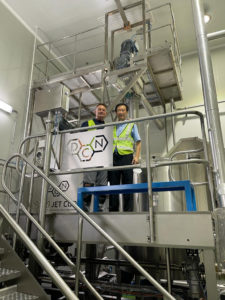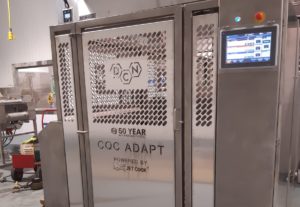DCN’s Jet Process Systems for Condensed Milk continue to be popular due to the high-speed processing, small footprint and large throughputs. Food Manufacturers can also expect to see a dramatic energy reduction compared to when using a traditional processing method.
By replacing liquid milk with milk powder, we remove the expense and need for chilled transport and storage. If using liquid milk, it may have come from a variety of different sources, which then require a lengthy stage to pre-prepare the milk. There is also a high degree of wastage as when you heat and evaporate liquid, you are losing 60% of the quantity.
Here we examine Jet Process in more detail:
Reduced Processing Times
A Jet Process System we designed, manufactured, and installed earlier this year in Kuala Lumpur can produce quantities of 5000kg in 23 minutes. Throughputs can be increased up to 12 tonnes per hour, with the addition of multiple Jet Cook Units – however the small footprint remains the same.
The lengthy multi-stage processing of the traditional method is replaced with a single-stage system with a small footprint. In the comparison below, step 1 in traditional processing takes 1 day, whereas with Jet Process this milk preparation stage is removed completely and the whole process takes just 23 minutes.
Watch the video
Improved Product Quality
Product quality is improved when using DCN’s system, as ingredient flavours are enhanced due to the reduced thermal impact of rapid heating and mixing.
Product trials which we ran after the commissioning of the new system showed the Condensed Milk had a brix of 72, and a particle size of 3 micron, ensuring a smooth creamy texture with highlighted dairy notes. The simultaneous heating, shearing of the oil, powders and sugar creates a homogeneous finish without the requirement of a high pressure mechanical homogeniser.
Traditional Condensed Milk Process (liquid milk)
Testing and adjusting the incoming liquid milk prior to processing:
Fat levels
Solids Non-fat
Micro-loading
Pasteurisation through heat exchanger to 120◦C for 1-3 minutes or:
Chilling to 70◦C before entering the evaporator
Mechanical homogenising
Cooling prior to canning
Typical Condensed Milk Jet Process System (milk powder)
Cook/Sterilisation/Entrain/Emulsify are all carried out simultaneously as one step:
Jet Cook – single or multi in-line (up to 4 units) – simultaneously and rapidly heat and shear the product to the final required temperature.
Jet Sterilisation – replaces a traditional heat exchanger, which can cause damage to the proteins due to the hot surface. The excess surface temperature can also cause a maillard effect, where lactose reacts with ε-amino group of lysine residue of milk proteins. This can have a negative impact on the flavour and colour of the product. The other disadvantage of a heat exchanger is long cleaning times of the tubes, and the volume of product left inside them after processing. The Jet Sterilisation pipework can be as little as two metres with no moving parts, and can be disassembled in a matter of minutes.
Jet Entrain – entrains 400kgs of powder in 4 minutes. The patented hopper and injector nozzle creates ultimate vacuum to disperse the powders into the liquid without any blockages, which can occur if there is wetting of the powder.
Non-mechanical In-Line Emulsification – using the In-line Jet Cooks on high shear whilst they also rapidly heat.
Lactose Seeding – not usually required with this system but can be added by customer request – as was the case with this customer.
The same system has the flexibility to make different products such as oat milk, evaporated milk, milkshakes, long shelf-life juices, sugar syrups, creamer, as well as maheu and brushera for the African markets.
To find out more about DCN’s Jet Process Condensed Milk systems, please contact info@dcnorris.com / +44 (0) 1767 677515
The post Condensed Milk Processing Equipment: Jet Process appeared first on DC Norris.






